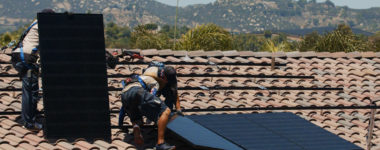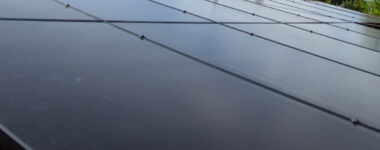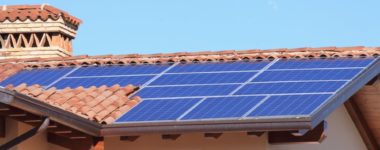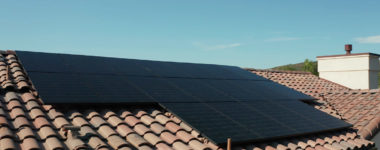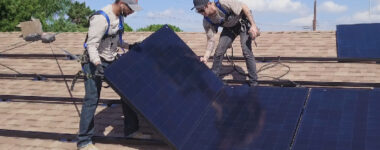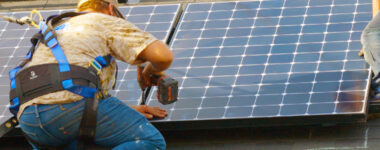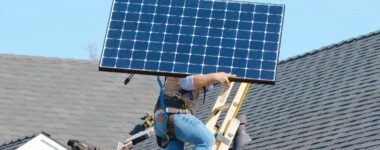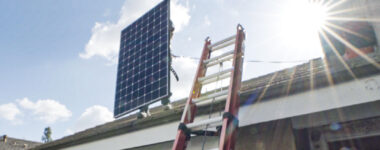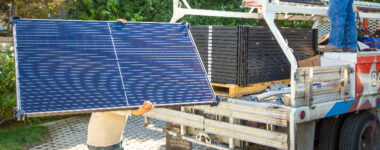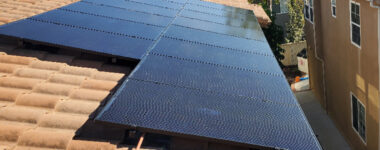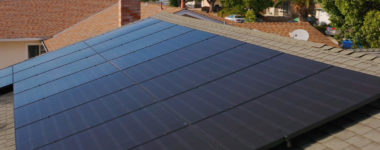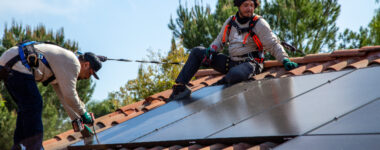Semper Solaris Blog
It’s easy to feel overwhelmed with the onslaught of alarming climate news. The polar ice caps are melting. Hurricanes and rising oceans are swallowing islands. Wildfires in California are getting bigger and badder. Oh, and what the heck is happening to all the bees? It’s enough to make you grab a tub of ice cream and hide under the bed. Before you give up all hope, remember the power of human ingenuity. Small actions from a lot of people can add up. Earth Day is almost here, and with it comes a reminder that you can fight the effects of climate change by making smarter environmental decisions in your life. That might mean something as big as investing in California solar systems, or something as small as using fewer water bottles this year. Every action matters. In honor of Earth Day on Sunday, April 22nd, here are five things you can do to lower your carbon footprint and fight for our beautiful planet and home. Install California Solar Systems Of course we would start with this one! Here at Semper Solaris, we help homeowners lower their carbon footprint every day by installing solar power systems on their homes and businesses. San Diego is one of the best cities in the country to go solar, thanks to our abundant sunshine and progressive utility companies that offer net metering. The average family used 10,766 kilowatt-hours (kWh) in 2016. According to the Carbon Fund, one kWh equals roughly 1.22 pounds of CO2. Families that invest in California solar systems that cover their entire energy usage could save over 13,000 pounds of CO2 from hitting the atmosphere each year. That’s a big deal! Buy an Electric Vehicle Unless you live in downtown San Diego or a beach community like Pacific Beach or Solana Beach, chances are that you need a car to get around. Each commute to work, grocery store run, or doctor’s appointment emits CO2. In fact, the typical passenger car spews out 4.7 metric tons of carbon dioxide a year! If you have a long commute and/or drive a vehicle with poor gas mileage, your carbon bill will be even higher. Don’t want to feel guilty for that midnight In-N-Out Burger run? Ease your conscience with your next car purchase and consider an electric car. These days, there are plenty of models on the market, from the sleek Tesla Model S to the mid-range Chevy Bolt and Ford Focus Electric. The Mitsubishi i-MiEV or the Smart Fortwo are perfect options for the driver on a budget. While electric cars tend to be more expensive than their gas-guzzling peers, you can nab federal tax credits for purchasing one of these cars. Additionally, with a little planning, your solar power system can cover the extra electricity your new set of wheels needs! Plan a Staycation You and your family deserve an awesome vacation each year, but flying is one of the most carbon-expensive actions you can take. A trip from San Francisco to New York will produce almost a metric of CO2 per passenger, which represents roughly 20% of all the greenhouse gases your car produces in a year. Does that mean vacation is canceled this year? No way! Instead, consider keeping your vacation a little closer to home. After all, you already live in one of the best vacation destinations in the world. In California, you can create almost any type of vacation you want. Walk down Hollywood Boulevard, take the kiddos to Disneyland, visit Alcatraz, lounge on a pristine beach, or shred it on the slopes. Here’s another staycation idea: while you’re doing your part to save the planet, why not remind yourself of what you’re protecting? California is home to 28 National Parks, including: Yosemite National Park Redwood National Park Joshua Tree National Park Death Valley National Park Sequoia National Park and a whole lot more! Reduce, Reuse, Recycle Maybe you’re not ready to invest in solar panels in San Diego or pick out a new car just yet. Lowering your carbon footprint doesn’t have to be an expensive endeavor or even that lifechanging. It can be as simple as reworking your current habits just a little here and there. What are some of the things you can reduce in your life? How about plastic water bottles and paper towels? Think about whether you can save water and electricity by waiting until the washer or dishwasher is full before running a cycle. It’s difficult to determine the environmental impact of every single product, but the Carbon Fund estimates that every pound of manufactured product costs 4 – 8 pounds of CO2. Think about that the next time you stop into your local big box retailer. Before each purchase, ask yourself, “Will this make my life better?” If not, then maybe you don’t really need a 50th pair of shoes or another magazine. When it comes to recycling, it really doesn’t take a lot of effort to toss your paper, glass, aluminum and recyclable plastics into the recycling bin. If you really want to step up your game, see if any local farmers in your area are accepting organic waste for composting. There are other ways to recycle. Give old clothes and things you don’t use anymore to Goodwill or the Salvation Army. Someone else can use it, which means they won’t have to buy something new! Carbon Offsets Living a more environmentally focused life doesn’t mean you have to give up every pleasure. Most human activity generates carbon in some form. It can be easy to start feeling guilty about every trip to the grocery store, every pack of new socks, or the flight you had to take for a business trip. Guilt and fear lead to resentment and feelings of depravation. That’s not what Earth Day is about, and it’s not a great way to live your life. Instead, give yourself permission to find a balance between eco-consciousness and fulfillment. One way to do this is to purchase carbon offsets to help balance out the ways you add carbon to the environment. You’d be surprised at how affordable offsets can be. A flight from San Francisco to New York will cost less than $11 in offsets through United’s offset program. Be careful when choosing a carbon offset company. Make sure your company is verified by an independent third party to ensure that it’s using your money in a way that really takes carbon out of the atmosphere (like planting trees) or prevents carbon pollution (like donating to a wind farm). Not sure which carbon offset company to choose? The Sierra Club recommends NativeEnergy. Carbon Reduction Lighting Round Thought we were done with the carbon reduction recommendations? Not so fast! A lot of the suggestions we’ve made require big changes to your life, but even small changes can have a big impact if you keep at them over the years and convince your friends and family to join you. Here are 10 quick, easy, and cheap ways to reduce your carbon footprint that you can easily turn into automatic habits: Unplug chargers and switch off power strips when they aren’t in use Lower your thermostat one degree in the winter and increase your thermostat by one degree in the summer Keep your tires inflated Make one day “meatless” per week Order chicken instead of steak Group errands together so you don’t take as many solo car trips Carpool to work Make a commitment to walk if your destination is less than a mile away Don’t speed Use a traffic app to avoid congested roads Celebrate Earth Day Earth Day is a chance to celebrate our potential. We’ve gotten ourselves into this climate change problem, and we can get ourselves out as well. This will require human ingenuity, passionate advocacy, and changes in how we live on a global and personal scale. At Semper Solaris, we are a veteran-owned solar installation company proud to be fighting this new battle. Solar panels help our customers save money and reduce their carbon footprint. If you live in San Diego, we hope you’ll celebrate Earth Day with us and consider scheduling a free energy analysis.
With the recent Pineapple Express storm pounding California with more rain and more extreme weather than usual, homeowners might be left wondering about the effect of weather on solar panels. Here’s what you need to know about how solar panels work and how weather may affect them. How Solar Panels Work without Sun The way solar panels work is because of a cell panel that converts sunlight directly into electricity. When photons (particles of sunlight) hit them on top of a roof, the panel turns the photons it receives into electrons of direct current electricity. The inverter then converts the direct current electricity into alternating current power, which can be used to power household items. A common misconception about solar panels is that they need direct sunlight in order to work. Although the sun is the main source of energy that they absorb and convert into power, the way that it is projected onto a solar panel cell doesn’t necessarily require direct sunlight. Solar panel cells actually just need the photons emitted from daylight sun. In other words, even if it’s cloudy out, the sun’s photons are still being spread into the atmosphere and absorbed into the panels. That being said, direct sunlight is still preferred over indirect sunlight for optimal energy absorption. On cloudy days, solar panels produce only 10 – 25% of their capacity. Factors that make this range an approximation include the density of the clouds, as well as the type of solar panel; some can handle diffused light better than others. Impact of Different Weather on Solar Panels Most solar panels are built to handle a wide range of climates and conditions, including heavy rain, hail, wind, heat and cold. This is good news for areas that are impacted by storms, rain and snow. During the manufacturing process, each solar panel is tested for extreme weather conditions to receive an Underwriter’s Laboratories (UL) certification. While this certification is a good baseline, it doesn’t mean that all solar panels uphold the same durability and quality. It simply means they have passed the minimum number of tests required to be certified. More specifically, high winds, snow, and cold temperatures shouldn’t be a concern. Top-rated solar panels are engineered to withstand winds of up to 140 MPH. As for harsh winters — cold temperature can actually improve solar panel output, and white snow can reflect light and improve photovoltaic performance. So long as panels aren’t covered in snow, winter climates can actually be an ideal environment for solar panels. Snow will usually melt and slide off panels easily; if it does build up, simply use a broom to brush it off. Of course, solar panels aren’t entirely invincible. Lightning and hail can damage solar panels in extreme cases. Consumers should look into their homeowner’s insurance policy, which usually covers solar panel damage if it is not included in the solar panel’s warranty. Additionally, be aware that hot climates may actually reduce the efficiency of solar panels. For any temperature above 87 degrees Fahrenheit, a one-degree increase in temperature can equate to a 1% decrease in efficiency. Durability of Solar Panels Most inclement weather won’t have a huge impact so long as they are high quality and boast durability as one of their main attributes. Many top-rated solar panels have a proven track record of durability, degrading at a slower rate than others. In fact, the manufacturer guarantees that the system will produce 92% of its rated power after 25 years of use. Durable solar panels also protect the roof of your home from harsh weather conditions, acting like a barrier. Panels are built to hold a certain weight, so the more durable your panels, the better they can withstand snow or hail. Proper Solar Installation to Withstand Any Weather Condition One key factor to ensuring weather doesn’t become a hindrance is making sure the panels are properly installed. Your money is on the line, so make sure the solar installation company that you go with is reputable among the solar industry. The installer should understand the types of local wind patterns and climate conditions your area typically receives, and help you pick the right solar panels to match these needs. Even if you live in California where the sunnier-than-average climate is ideal for solar , it’s normal to wonder how the weather might affect their efficiency. The science behind how panels absorb photons speaks to why they still work on cloudy days, and the durability of the panels allows them to withstand just about any weather scenario. At the same time, it’s important to choose the best quality solar panels and look for an installation company that can properly install panels so that they are secure and ready to face any weather condition. To find out more about what makes a top-rated solar panel worthy of installation, start by asking these 10 Questions About Solar Panels — that way you can ensure your panels will remain sturdy on your roof, whatever the weather may be.
As you near retirement, it’s important to think about reducing your energy costs to maximize your savings. Solar is a popular option for cutting those utility bills. If you’ve done your homework and decided solar is the right choice, it’s time to ask yourself, “Who are the best solar providers near me?” Unfortunately, California households face increased electricity prices compared to other homeowners despite the fact we use about 31 percent less energy on average. Consulting with solar providers near you is the first step toward reigning in those excessive costs and keeping more money in your wallet. Discover the advantages of going solar and the available solar providers in your area. Advantages of Going Solar As you consider setting yourself up for optimal quality of life during these retirement years, your financial stability is probably one of your largest concerns. One of the biggest advantages of investing in solar during retirement is that it stabilizes your electrical spending, helping you cut out a variable cost and one of your biggest household expenses. In fact, you could be putting more than $1,000 extra back in your account every year. This allows for more enjoyment in your “golden years”! What are some other key advantages of investing in solar now? Helps reduce greenhouse gases and protect the planet for years to come Current federal and state tax credits offer great savings Greatly improves the value of your home Solar investment returns are not taxable (excluding SRECs – Solar Renewable Energy Credits) Protecting your well-being is important, and switching to solar energy can play a major role. More than that, you can help contribute to a cleaner tomorrow for future generations. With utility costs going up every year, there is no relief for Californians’ outrageous energy bills unless they switch to solar. Why Trust Semper Solaris With the Job? Not many companies treat customers with the respect, care, and attention that Semper Solaris provides. What makes us unique? We are a company that is founded on military values. These roots mean that we take your trust in us seriously. Especially for customers heading towards retirement or already there, we understand the value of every investment you make. That is why we review all your options with you, from buying the system outright to buying the system with a loan or having a solar lease. Taken from the Marine Corps motto, Semper Fidelis, Semper Solaris vows to remain always faithful in our service to you. On top of that, we offer the best prices in California and discounts for military, police, and firemen. Our locally and veteran-owned solar company is ready to tackle your solar panel installation. If you're looking for a solar provider near you, we service both the San Diego area as well as the Los Angeles area. Give us a call today if you’d like to find out more about the value of solar as a retirement investment.
One of the most common questions we get from prospective clients is: How many solar panels will I need for my house? It’s a good question, because the number of solar panels you need will of course affect the price of your solar panel installation. The number of solar panels you need for your home will depend on how much energy you typically use, where you live, and the efficiency of your solar panels. According to the U.S. Energy Information Administration, in 2016 the average U.S. family used roughly 10,000 kWh (kilowatt hours) of electricity, which would require about 16-20 solar panels. That’s the average, but you’re not average, right? In this article, we’ll help you figure out how many solar panels you need to power your life here in sunshine-rich Southern California. Your Energy Usage The first step in determining the size of your solar installation is to figure out how much energy you use. The last thing you want is to invest in a solar power system that doesn’t produce enough energy or produces more than you need. This average household data we mentioned above provides a baseline, but it might not be relevant to you. A family of six in a 5,000-square-foot home in San Marcos with a heated pool and two electric vehicles is going to use a lot more energy than a couple living in a 2,000-square-foot home in Carlsbad who don’t drive electric cars or have a swimming pool. You can find your typical energy usage by looking up your energy bills for the past year. These should be available by logging into your electric company’s customer portal. Each bill should include your total energy usage in kilowatt hours for that month. Add up the amount for the past twelve months and then divide by 12. Viola! You’ll have your average monthly energy usage (typically between 850 and 1,000 kWh). Assuming you want your solar panel system to cover all of your electricity needs, you’ll need to install a system that can produce this amount each month. Where You Live Where you live also plays a role in how many solar panels you need for your home. Americans who live in states like Washington and Maine have to endure long winter nights and many overcast days of the year. Their solar panels get less sunlight, which means they have to put more panels on their roof to produce the same amount of electricity as someone living in a sun-rich state like California. Of course, just because the sun is in the sky doesn’t mean your solar panels are producing at max capacity. For example, sunrise and sunset won’t help your panels generate much solar energy, because when the sun sits at such a low angle, the atmosphere filters a lot of the light. Also, rates of sun can even vary from house to house depending on external features (like tall trees or a big hill behind your home) that affect how much sun you get. When calculating how much electricity your solar panels can produce, it’s more important to figure out how many peak sun hours your location receives on an average day rather than just the amount of time the sun is in the sky. Without getting too technical, you can think of a peak sun hour as an hour when your panels are receiving strong, direct sunlight. (If you do want to get technical, a peak sun hour is when the intensity of sun is 1,000 watts per square meter.) In the U.S., most areas receive an average of three to five peak sun hours per day. When you schedule your energy analysis with a solar installation company, an energy expert will help you determine the average daily usable hours of sunlight your home receives. Solar Panel Efficiency Not every solar panel is alike. Different brands offer different levels of efficiency. When we talk about efficiency, we mean how much electricity each panel can generate in an hour. Depending on which brand of solar panel you choose, you can expect an efficiency anywhere from 250 to 350 watts per hour. (Note – these numbers always refer to the amount of energy produced during peak sun hours.) That difference adds up. Let’s assume your home receives four hours of peak sun hours a day. A 250-watt panel will produce 1kWh per day (250 watts x 4 hours). That’s around 30 kWh per month in a 30-day month. A solar panel that produces 350 watts will give you 42 kWh in that same month. While higher efficiency solar panels tend to be a little more expensive than their less efficient counterparts, they can end up saving you money if you need to purchase fewer solar panels. They’ll also take up less room on your roof! At Semper Solaris, we are proud to use SunPower solar panels, one of the highest quality and most efficient solar panels on the market. Calculating How Many Solar Panels You Need for Your Home As mentioned above, our energy experts will help you determine how many solar panels you’ll need. If you’d like to estimate this beforehand to start your planning, here’s a quick example of how you can crunch the numbers: Say that you own an electric car and aren’t about to scrimp on using your air conditioning in the summer. Your average monthly electricity usage rate is a little higher than average at 1,000 kWh per month. During your energy audit, the solar representative mentions that your area receives a daily average of 4.5 peak sun hours. After discussing your options, you consider high-efficiency solar panels that can produce 300 watts per peak sun hour. Let’s do the math. 300 watts x 4.5 peak sun-hours = 1,350 watts One solar panel on your roof will produce an average of 1,350 watts or 1.35 kWh per day. 1.35 X 30 = 40.5 kWh per month (assuming a 30-day month). You need a solar panel system that produces 1,000 kWh per month. 1000 kWh / 40.5 kWh = 24.69 solar panels. Whew! That was a lot of math, but we got our answer. Your home would need roughly 25 solar panels in order to meet your existing energy needs. You’ll notice that this number is actually lower than the average mentioned at the beginning of this article. That’s because we get higher-than-average amount of peak sun hours here in San Diego, and because this scenario incorporates high-efficiency solar panels. No wonder Californians love solar panels! This article should help you get a general idea of the number of solar panels you need, but to get an accurate estimate, request a consultation with a knowledgeable and reliable solar panel installer in your area. If you live in California, take a look at our serviced locations and schedule a free energy audit with Semper Solaris.
If you live in San Diego, you’ve gotten used to seeing solar panels perched on the rooftops of homes and businesses, but are these panels only meant to power blenders and keep the air conditioning running? No way, Jose! Solar panels are like the nerdy kid who just became popular. The trend that started on the West Coast is showing up everywhere – on RVs, planes, backpacks, and even dog houses. Yes, Rover is totally getting into the solar energy game. It’s time to think out of the box when it comes to California solar. Here are six cool and unique ways you can use solar power in your life. 1. Power Up Your Electric Gadgets and Luxuries If you’re thinking about investing in solar for your home, consider that your new solar power system can cover all your current energy needs and give you the perfect excuse to invest in some new electric toys. The top of this list for most people is an electric car. Gas isn’t cheap here in California, so if you can cruise up the 5 using a battery powered by the sun, that can add up to great savings. Take your pick from the Chevy Volt, to the Tesla Model S (which could go well with your Tesla home battery), 2018 BMW i3, and more. With nearly every major car manufacturer focused on going electric, the list of choices will only keep growing. But don’t just stop at electric cars. Now is the time to put in that heated pool or hot tub the kids have always wanted, or the new theater system you’ve always wanted. Add cool outdoor lights to show off your backyard. Heck, your solar power system can even give you enough juice to start mining for cryptocurrency or charge your family robot… you know, when those become more of a thing. Just make sure you tell your solar power specialist what your future energy needs will be so they can recommend an adequate system size for your home and extras. 2. Take the Ultimate Road Trip with Solar-Powered RVs and Vans Have you ever dreamed of hitting the open road for weeks or even months at a time to explore every nook and cranny of the country? Well, you’ll still have to figure out a way to keep the fridge running and the lights on without draining your car battery every few days. Many enthusiastic RV and van dwellers have wholeheartedly embraced solar power in order to run things like refrigerators, hot plates, lights, water pumps, and even televisions - no matter how far off the beaten path they go. Alexandra Ulmke who writes the popular blog A Girl and Her Van explains that solar panels “are efficient, relatively cheap, and provide enough power to stay off the grid for weeks on end.” In this educational blog post, she explains step by step how she retrofitted her van with solar panels to keep the energy flowing. 3. Avoid a Dead Phone While on an Adventure with Solar-Powered Backpacks In this day and age, our phones, laptops, and other gadgets aren’t just luxuries. They’re necessities. That’s why it can be a minor emergency when your phone battery goes into the red. What if you’re trying to navigate to a brand-new place, waiting for a call about a sick family member, or hiking in the woods far from civilization? Fortunately, a growing line of solar-powered backpacks can ensure you always have a ready energy source to charge your gadgets. These backpacks come in all sorts of styles, from sleek and professional to a true adventure pack. You can even get a solar-powered water bladder backpack for those long solo-runs. Prices for solar-powered backpacks range from this budget-friendly option to this hiker’s dream come true. Want to be even kinder to your wallet? Skip the backpack altogether and just pick up this convenient portable solar panel that you can unroll when needed or even attach to a normal backpack during your outdoor adventures. 4. Discover a New Way to Get Around Town with Solar-Powered Bikes Just because you don’t have $79,500 to plunk down on a 2018 Tesla Model X doesn’t mean it’s time to give up on your solar-powered transportation dreams. Electric bikes are becoming an increasingly popular mode of travel, especially in places like San Diego where the weather is gorgeous year-round. Electric bikes offer power-assisted pedaling to help you rocket up hills and cruise for miles while hardly breaking a sweat. That nice little boost comes courtesy of a lithium ion battery that powers a small engine connected to the bike. Some e-bike enthusiasts are taking the next step and hooking their batteries up to solar powered systems. One ingenious startup based in Copenhagen, Kvaern, is even offering a cool e-bike that comes with a solar-powered battery charging pack. 5. Go Up, Up and Away with Solar Powered Planes San Diegans have gotten used to seeing electric-powered cars on the road, but it might be time to start looking up! Enter Google co-founder Larry Page, who recently took the wraps off a new company called Kitty Hawk. The company’s main product is an electric, self-flying air taxi that takes off like a helicopter and looks a little like the pod that brought Superman to earth with wide wings attached. The company has been performing stealth flights in New Zealand and working directly with the island nation’s government to develop an official certification process, with the goal of offering commercial flights in three years. But Kitty Hawk isn’t the only company in this space. Boeing, Airbus, Uber, and others have all been toiling away, trying to design their own air taxis. What makes Kitty Hawk unique, though, is that its electric power system means that it could potentially be powered using solar technology, creating a truly carbon-free mode of air transportation! 6. Make sure Rover Loves Being in the Dog House with a Solar-Powered Dog House We spoil our dogs with manicures, dental work and all the latest and greatest toys. It was only a matter of time before Rover’s dog house got upgraded with solar panels to make his abode even more luxurious. Inventive pet parents are installing solar powered systems that can heat dog houses in the cold winter and power fans during the hot “dog days” of summer (we couldn’t help ourselves). According to an article in PetGuide.com, solar power has also been used to power automatic food and treat dispensers, water purifying systems and even pet cams. Turns out, staying in the dog house isn’t such a bad place to be. How Are You Going to Use Solar Power? Going solar in California has a whole new meaning now, doesn’t it? While the vast majority of solar systems are installed to power homes and businesses, enterprising and creative people can adapt solar technology for a whole host of unconventional uses and exciting new products. As this technology continues to get cheaper and more prolific, it will truly revolutionize the way we power our world and our lives. At Semper Solaris, we are proud to be part of this California-led revolution. If you want to join the solar power party, contact us today for a free energy audit of your home.
With Tax Day looming, you may be scrambling to get your finances in order. And if you’ve already filed, you might be looking ahead to this year to make sure you’re set up for financial success. If you’ve had solar installation done, you could qualify for multiple tax breaks and rebates at the federal, state, and local level. Little did you know that while you’ve been saving costs on electricity bills and doing your part to reduce carbon emissions, you’ve also been doing your taxes some justice. As you file your taxes, there is light at the end of the tunnel, and that light is solar-powered. Here are three major ways solar installation may affect your taxes to your benefit. 1. Solar installation might qualify you for a federal tax credit. While the cost of your actual solar installation may have seemed like an expensive investment, just know that you’re saving money in the long-term. In order to help lessen the initial financial burden solar energy installation may cause, the Environmental Protection Agency and Department of Energy offer tax credits for solar-powered systems. The solar Investment Tax Credit (ITC) incentivizes Americans to adopt solar energy, driving the growth of the solar industry. It applies to owners of residential and commercial properties that have had solar panel installation. If you’ve installed solar power systems within your home, you may qualify for a federal tax credit of up to 30% of the total cost. To put that in perspective, a solar power system that costs $25,000 may be eligible for a $7,500 federal tax credit. It’s important to note that this credit is not applicable to rental properties that are rented out. Although you may own it, you must live in the home to claim the credit. If you live in the rental home for a portion of the year, then you can still receive a prorated credit; that is, the percentage of the year you stay there is the percentage of the 30% tax credit you would receive. Additionally, keep in mind that the ITC will be gradually reduced in the next few years. 2. State and local rebates may also be available to solar power system owners. In addition to the federal tax incentives for solar panel installation, there are some state and local rebates and credits solar owners can take advantage of. Each state is different—you can check the Database of State Incentives for Renewables & Efficiency to see what potential tax breaks are available for renewable energy installments within your specific state or city. If you live in California, for example, you may have heard of the California Solar Initiative (CSI). The initiative offered cash incentives on solar systems, available to customers of Pacific Gas & Electric, Southern California Edison and San Diego Gas & Electric. While the program has expired, there may be local solar rebates you can take advantage of depending on where you live, such as those through the Los Angeles Department of Water and Power and San Francisco Public Utilities Commission. With the end of the CSI, Semper Solaris also offers our own rebates throughout the year to make up for the lost incentives for solar installation. To learn more, take a look at our Current Offers. 3. Residential energy property credits may be given for making overall energy-efficient home improvement. It’s smart to think outside the box — or outside the home — when it comes to what you could get a tax break on. Beyond an overall home solar energy system, any improvements you make to your home that make it more energy efficient can also qualify toward federal tax credit. This includes energy-efficient windows, doors, skylights, heating and air-conditioning systems, insulation, water heaters and roofs. Naturally, solar installation can indirectly cover many of these appliances and generate the power to run them in an energy-efficient manner. Installing alternative energy equipment can also count toward the residential energy efficiency property credit. A solar water heater and small wind turbines are examples of appliances that qualify. To note, there can be limits to these credits depending on the type of alternative energy improvement. Although some alternative energy upgrades may not call for solar power, many do. Your roof is one of them, as solar panel installation usually starts with upgrading the roofing of a house. It’s the main spot where the sun hits, so installing energy-efficient panels is a key way to save with both tax credits and on electricity. From federal tax credits to state-specific programs to local rebates, making your home more energy efficient and reducing your carbon footprint can be a profitable investment. Tax Day doesn’t have to be daunting when you know that you’re getting the most bang for your buck with your solar power system in place. If you haven’t yet benefited from solar panel installation, learn more about the advantages of solar installation and get your free solar quote today!
California is no stranger to solar panels. Los Angeles, the largest city in the Golden State, is helping to lead the way in solar power system adoption. The rising popularity of solar panel installation in Los Angeles is fitting, given various factors including government incentives, favorable climate and the global effort to reduce carbon emissions, and the city’s influence in growing the solar industry in general also holds significant value. How Los Angeles Helped Pioneer Solar Power Implementation in California The Los Angeles area has played a historic role in solar power commercialization. Dating all the way back to 1979, the world’s largest photovoltaic (PV) manufacturing facility was constructed in Camarillo, California, just north of L.A. in Ventura County. Additionally, the city played a further role popularizing solar in California when the Los Angeles Department of Water and Power worked with the Department of Energy, Southern California Edison, and the California Energy Commission to design the Solar One program that was the first to test a large-scale thermal solar tower power plant in 1981. Supplementing the overall spread of solar energy in California, the state’s Pacific Gas and Electric Company created the first-ever, grid-supported photovoltaic system, considered the first “distributed power” PV installation. With all these foundations for solar energy technology in place, it was just a matter of time before the city’s residents could really start to benefit from this alternative form of electricity. Adoption of Solar Panels in Los Angeles Even though its setting would imply otherwise, solar panel installation in Los Angeles wasn’t necessarily the most popular in most recent decades. In 2012, L.A. didn’t make the U.S. Department of Energy’s top 25 “Solar America Cities,” while both San Diego and San Francisco did. The reasons behind this could be attributed to high-cost solar power previously held and the city’s larger use of the cheapest form of energy produced from coal. With more recent and significant dips in the cost of solar energy - along with the rising electricity rates - a positive shift toward installing solar energy has taken up momentum. The need for cleaner air in the well-known pollution-filled city of L.A. has further helped to drive the switch to solar energy. In September 2010, an executive order signed by the city’s Former Governor Arnold Schwarzenegger, and approved by the California Air Resources Board, required the Los Angeles Department of Water and Power to produce at least one-third of its energy by 2020. To do this, the city partnered with UCLA to study the feasibility of an incentive program for promoting distributed solar energy usage. Pro-solar, statewide initiatives were also a major supplement to these city-driven mandates—the main one being the California Solar Initiative (CSI) as well as the overall Go Solar California campaign. The CSI program works to benefit customers of Pacific Gas and Electric (PG&E), Southern California Edison (SCE), and San Diego Gas & Electric (SDG&E). Overall Shift Toward Sustainable Energy Outside California and the U.S., an overall shift toward adopting sustainable energy is happening around the world. In 2015, nearly every country in the world participated in the first global pact, the Paris Climate Agreement, that was aimed toward reducing emissions of greenhouse gases. With this accord, each country would make a conscious effort to set goals toward decreasing their carbon footprint in order to slow down the possible negative impact on the earth’s atmosphere. Organizations and businesses around the world have also caught on to this trend of innovating their operations and products to be environmentally friendly. Tesla, for example, is a company that prides itself on creating technologies that work to accelerate the universal transition to sustainable energy. It has invented multiple products like electric cars that run on clean energy and is currently in the process of producing a stationary battery for powering the home. SpaceX’s Hyperloop One reinvention of transportation using alternative electricity sources and technology is currently being tested and the concept could come to fruition in the very near future. Another trend toward sustainability lies in waste-to-energy conversion. To address a growing crisis in waste management around the world, cities and governments are finding ways to turn trash to “gas”—to reduce waste and emit fewer emissions. These alternative solutions for energy are addressing the world’s issues and are helping to keep momentum toward making sustainable energy sources the norm. Meanwhile, the increasing need to stay connected and share information is helping to fuel the trend to “go green” and helps consumers to understand the negative impacts certain types of energy sources could have on the earth. With Los Angeles being one of the major cities within the United States, it can be looked at as a leader in sustainable practices, starting with greater adoption of solar panels in Los Angeles. Why Solar Power Installation in Los Angeles Will Continue Rising Los Angeles upholds a reputation of holding forward-thinking ideals, with its people being on the pulse of the latest trends, technologies, and news. With increased energy costs, government-mandated initiatives, and incentives to go solar in place there is a general shift toward sustainable energy throughout the country. And this perfect storm has created this rising popularity of solar panels in Los Angeles. If you are looking to contribute to the positive momentum and be a hero in your own right, give us a call for solar panel installation in Los Angeles. Semper Solaris is the most trusted solar power company in Los Angeles County, with unmatched expertise in solar power. We’ll get you on your way to saving not only money via lower electricity bills but also to drastically reduce your negative environmental impact via the switch to solar.
The abundant sun and ideal climate makes California a fairly easy place to decide to switch from traditional to solar energy. The harder part, though, is choosing which of the solar power companies in California is the best for your solar installation. Competition is fierce and the vetting process can get overwhelming when you sift through all the options. To ensure you make the right choice, here are the top four qualities a legitimate, reliable and high-quality solar power company should have. 1. A Good Reputation in the Solar Community Googling “solar power companies in California” is likely the first step you take in your search for solar energy services. When the search results come up, and you click individual businesses that can fulfill solar panel needs, do your due diligence and see if the company has a good reputation. There are various angles you can look at that reflect the reputation of a business. Look at reviews and testimonials not only on the company’s website, but also from outside sources like Yelp. Also, check if there have been any mentions in the news for the solar businesses you find. For example, a solar company may be featured or talked about in a niche solar power publication. If the article is favorable to that company, it’s a good sign that they are likely reliable and respected in the solar community. How long an installer has been in the industry can also be indicative of the quality of work they will provide. In addition to internet research, keep your ears open for word-of-mouth buzz about solar power companies. California is an obvious place for solar installation and those neighbors of yours may have used a reliable and trustworthy installer in the past. Don’t discount first-hand accounts of the work a specific solar company can do—a lot of times, it’s a more powerful source than anything you can find online 2. Dedicated to Only Using the Top Solar Panels and Products As you do your research on solar installation providers, find out what type of solar panels and products each one is using. Remember that the quality of the products being installed is just as important as the quality of labor being provided. When assessing different solar power companies in California, check if prospective companies will provide a free evaluation. This is a good sign that a business doesn’t just provide the installation, but that it also offers expertise on the matter. The solar panel company should be able to provide an evaluation and options for the type of solar panels that are the best fit for your house. The amount of space where solar panels can be installed is a huge factor and will inform which category of solar panels to be used. Additionally, when a company uses solar panels that use the latest technology—it’s a good indication that they care that you get only the best product. Many top-rated solar panel manufacturers guarantee that the latest technology is used when it comes to solar energy. Finally, aside from the actual solar panels, look to see if a company uses roofing and installation products that promote durability. This factor is crucial to building a solid foundation for your solar panels to be placed on. 3. Personal Attention What sets a good solar power company apart from a great one is the personal attention a company provides you. The relationship between you and your solar company should be a strong one, built on trust. Look for solar power companies in California that are known to constantly keep communication open with their customers and make their customer’s happiness a priority. Semper Solaris’ motto focuses on core values like trust, loyalty and a hard work ethic. We believe in making solar a personal matter, engaging with customers face-to-face on a regular basis in order to establish a relationship that transcends beyond just solar installation. By doing this, we have the ability to address any issues immediately and provide greater quality service to each and every customer we work with. 4. Proper Certifications Be sure to weed out legitimate solar panel installers from other ones by checking certifications. In California, for example, some installers may be certified by the North American Board of Certified Energy Practitioners (NABCEP) to install photovoltaic (PV) and solar-thermal systems. This certification guarantees that they have at least one year of experience installing systems, have passed an exam and continue their education in solar panel installation for recertification every three years. A solar company should also hold general contracting, electrician and home improvement licenses as well as general liability insurance. Holding the proper certifications for such large home upgrade is crucial to ensuring that your solar panels are installed with the best quality labor that can be provided. As you go about your search for solar power companies, California’s saturated market can be an intimidating place to look. The installer you choose should have specific qualities, one of which includes a focus on providing personal attention and high-quality work with top-of-the-line solar panels. Additionally, a solar company’s employees should be qualified in the special trade work that’s about to be done on your home. It’s easy to assume that the labor you hire already holds those certifications, but double check on your end to avoid any problems with installation. Not all solar power companies are the same. Trusted work and reputation among the industry will help guide you in picking the right one to upgrade to the new way to save on home energy needs.
Every single hour, the sun pours 430 quintillion Joules of energy onto the earth. That’s enough energy to power our blenders, cars, airplanes, air conditioning, and every other human energy need for an entire year! It seems like we should be able to find a way to harness all that sunlight, right? Well, that’s exactly what solar panels are designed to do. If you’ve considered installing a solar power system on your home, you probably want to know how thin panels on a roof can charge your electric car or keep your home nice and cool during a particularly hot California summer. Below, we’ll dive into the science of solar energy. Don’t worry, you won’t need a chemistry degree to keep up. We’ll break down the process step-by-step and make it easy to understand how solar power for your home is possible. How Solar Panels Turn Sunlight into Solar Energy The central challenge in using the sun to power homes and cities is figuring out how to turn sunlight into a power source we can actually use. In a nutshell, solar panels work by turning photons from the sun into electrical energy. Unfortunately though, you can’t use photons to power your cell phone or keep the lights on at night until it is turned into electricity. And the conversion process starts with a special substance called silicon, a crystalline element with strong semi-conductive properties. While other semiconductor materials can be used, the vast majority of solar panels are made of silicon, because it is one of the most common elements on the planet and is therefore easier to access (and less expensive) than other options. For each panel of photovoltaic cells, there is silicon sandwiched between the conductive layers. Here’s where the process gets a little sciencey, because each layer is slightly modified. The top layer is changed so that it holds a negative charge, while the bottom layer is turned into a positive charge. The attraction of these two layers (negative and positive charges are drawn to each other) creates a powerful electric field, which is a key ingredient in the solar panel recipe. Next, it’s time for a quick chemistry lesson and then lots of sunshine. It’s All About the Electrons Like every element on earth, silicon is made up of numerous tiny atoms. An atom contains a stable nucleus of neutrons and protons surrounded by zipping electrons. For our purposes, we’ll just focus on those electrons. Electrons have a negative charge and are drawn to the positive charge of protons. This bond isn’t unbreakable, though. In fact, electrons can be stolen by other elements or knocked out of their atoms by an intruder. This is exactly what happens when photons come pouring down on a rooftop solar system during a sunny day. Those little photons knock electrons out of their orbits, and the electric field kicks them out of the silicon field junction altogether. Don’t worry, these little guys aren’t lost, though. They just need to take the long way round. After electrons are booted from the silicon field, they’re captured by an external circuit. The electrons flow down the circuit, and this is what creates electricity. Eventually, the electrons return to the solar cell where they align back into the orbit of a silicon atom that needs an electron. In this way, nothing is lost or used up - like when fossil fuels are burned to create electricity. In fact, a solar panel system is completely self-contained and helps many people create self-sustaining homes in California. Converting Solar Power into Usable Energy The power created by that journeying electron we just mentioned isn’t quite ready to go right down into your electric socket and power on your stove in the morning. One more conversion has to happen. Solar panels turn photons into a special type of current called a direct current (DC), but here in the United States, our electrical grid runs on an alternating current (AC). This means that no solar power system is complete without a special device called a inverter. Despite its name, an inverter doesn’t turn DC into AC. Rather, the direct current powers the creation of the alternating current, which can then be used to power a home. The final destination for your alternating current will depend on the setup of your solar power system. Most homeowners in San Diego and other parts of California are part of the net metering system, which means that the excess electricity produced by their solar panels goes into the public utility grid. If you have this system, your electricity meter will actually tick backwards when your system produces more electricity than you can use. At night or on cloudy days when you need to use more electricity than the solar panels on your home can produce, the system will automatically pull electricity from the grid and your meter will go forward. A well-designed solar power system should balance out each month, producing the amount of electricity you need so that your electric bill is low, non-existent, or even shows a net gain. The other option is to install a solar battery in your home that can collect the excess electricity your system produces. At night or on cloudy days, you can power your house from the battery. Battery technology continues to improve, and it might be the right option for those who live off the grid or who want to be as self-sufficient as possible. Now You’re Solar Smart Now that you have a basic understanding of how solar panels work, remember that a single photovoltaic cell can only produce a little bit of energy. It might create enough to charge your cell phone, but not nearly the amount you need to keep your home humming - which is why each solar panel is made up of many photovoltaic cells, and panels are combined to create a complete solar power system. Several factors go into determining exactly how many solar panels you will need for your home, such as the size of your roof, your electricity needs and the amount of sunlight your home receives throughout the year. That’s why we always recommend getting a complete energy analysis and onsite evaluation. At Semper Solaris, we believe it’s important to make sure you have a solar power solution that fits your needs, which is why our evaluation is free. We want you to understand exactly what you’re paying for and how your new investment works, so don’t hesitate to call or email us with your questions!
As people of all ages learn more about humans’ impact on the planet, it’s more important than ever to teach future generations how to decrease their carbon footprint and care for the earth. After all, kids are the leaders of tomorrow. Renewable energy sources continue to gain steam across the country, and it’s essential to teach our youth about the myriad of options — including solar, wind, hydro, geothermal, and even biomass energy. Find out how to introduce future generations to solar panels and energy conservation, and browse additional resources on all types of renewable energy. Renewable Solar Energy Solar energy is radiant light and heat that can be harnessed from the sun using a range of ever-evolving technology such as solar panels. Solar energy is a dominant source of power and can be used in a variety of ways. Solar energy can be used as an energy source as well as a heat source. Many utility companies are starting to use photovoltaic systems, a process in which solar energy is directly converted to electricity using photo-voltaic devices on solar panels. Solar energy has a lot of promise, however, some drawbacks include the manner in which solar energy arrives at the surface of the Earth and the large area that is needed to efficiently collect the energy. Wind Energy Wind is basically air in motion and scientists have begun harvesting wind to create power. Today’s windmills are much more efficient than those of the past and are able to collect kinetic energy from the wind, creating power. Hydro Energy Hydro-power is a reliable, renewable, and clean source of energy that converts the kinetic energy produced by falling water into electricity. Hydro power does not consume any more water than is produced by nature, making it a promising form of renewable energy. It is also one of the oldest methods used by the human race for creating electricity. To generate electricity, water must be moving at a sufficient volume and speed to cause a generator to turn. Often, dams are used to increase the force of moving water. Geothermal Energy Geothermal energy is an efficient way to produce heat in small applications given that consumers need to be located near the source of the heat. Geothermal energy is basically heat from the Earth, and is an important source of energy that has many advantages over nuclear and fossil sources of energy. The heat created by the Earth can be used as a source of energy in many ways from small pumping stations to large power stations. Geothermal energy can be found nearly anywhere and tapping into it has proven to be a sustainable and affordable alternative to fossil fuels. Geothermal energy can be captured with binary, flash, and dry steam power plants. Biomass Energy Biomass is organic material that has sunlight stored in the form of chemical energy. Biomass fuels include straw, wood waste, wood, sugar cane, manure, and other byproducts produced from different agricultural processes. Biomass is considered a renewable form of energy because the energy contained within it is produced in part by photosynthesis. Biomass is sort of considered a battery that can store solar energy indefinitely. There are many types of biomass and many ways that it can be used to provide energy. Conserving Energy While it is important to understand the different forms of renewable energy, it is also important to know about nonrenewable energy, which is still mainly used today. When informed of the consequences of using nonrenewable energy, future generations can do their part to help with conservation. Kids can be engaged through hands on activities, so teach them about different things they can do at home and within their communities to contribute to conservation. Learning about different types of energy can be fun for all ages. Check out how homes can be powered by renewable energy and how solar panels work. More Information on Renewable Energy for Kids nergy Smart Inventions and Renewable Energy Sources Renewable Energy Basics for Kids Energy and the Environment Environment for Kids – Renewable Energy A Lesson on Renewable Energy Exploring Alternative Energy Sources Renewable Energy Education for Teachers and Students Renewable and Nonrenewable Energy Sources Lesson Plan Solar Companies Solar Panel Replacement Cost Best Solar Company San Diego Solar Panel Installation Cost Apple Valley Solar Installers Local Installation & Repair Solar San Diego Bay Area Solar Rancho Cucamonga Solar Panel Installation Los Angeles Residential Solar Power Energy Assessment Solar Panel Rebate
With abundant sunshine and the Pacific Ocean in its back yard, San Diego has always been an eco-friendly, forward-thinking place. That’s why it leads the U.S. in solar energy installments. In fact, going solar in San Diego is a common theme for America’s Finest City and its residents. The county increased its solar capacity 60 percent in the past year to 303 megawatts. If you’re looking to live in sunny San Diego (or even if you already call it home), here are the top neighborhoods to go solar based on key factors that add to the overall quality of living. 1. Del Mar The coastal city of Del Mar (Spanish for “by the sea”), takes the number one spot for the top neighborhood in San Diego County. It’s ritzy, yet laid back beach-town vibe makes it a pleasant place to live for many residents. Just about 30 minutes north of downtown San Diego, the area is home to many families and its public school system receives an A+ rating, ranking the #4 suburb with the best schools in the state of California. When it comes to fun activities, Del Mar is famously known for being home to the historic Del Mar Racetrack, where horse races take place all summer long and the town is also one of the only places where Torrey Pines, the rarest pine tree in the United States, grow. Hike, surf, bet on the ponies or just enjoy a stroll in the sunshine - Del Mar boasts breathtaking views around every turn and excellent beach-front weather, making it a go to place to install solar panels in San Diego. 2. Solana Beach The apple doesn’t fall far from the tree, as Solana beach, the neighboring town of Del Mar, ranks second as a top neighborhood for solar in San Diego. Solana Beach has a population of 13,000 and is known for its beach, eclectic shops, dining, nightlife, golf courses and hiking scene. It averages a comfortable 62 degrees during the winter season and 77 degrees during the summer time, with a near two-mile stretch of coastline to enjoy. Locals frequent Fletcher Cove Park, a favorite spot to catch beautiful sunsets. Commuter-friendly Solana Beach houses a major train station stop (one of only three in San Diego County) that serves both Amtrak and the Coaster and residents have easy access to San Diego’s major freeways, including the 5 and the 101 interstate highways. With its outdoor-friendly sentiment, this town upholds environmental consciousness, making it a chief contributor to a more solar San Diego. 3. Encinitas Moving further up the cost, the town of Encinitas is another top pick for places to go solar in San Diego. Encinitas was named among the 20 best surf towns in the world by National Geographic and sits along the historic coastal Highway 101. It’s home to 62,000 residents and is segmented into five different areas: Old Encinitas, New Encinitas, Olivenhain, Leucadia and Cardiff-by-the-Sea. Each of these communities has its own personality offering a range between an oceanfront beach life to more rural, family-oriented suburbia. Old Encinitas sits along the coast and is known for its famous surf break, Swamis. In Olivenhain, you can find private equestrian facilities and mainly single family homes. New Encinitas boasts numerous golf courses and shopping centers, while Leucadia is a place of tree-lined streets, art galleries and eclectic stores. Cardiff-by-the-Sea is an oceanfront community and home to the San Elijo Campus of Mira Costa College. Encinitas has something for everyone, which makes it extra appealing to live and reap the benefits of solar year round! 4. Coronado Just south of downtown San Diego, across the signature Coronado bridge is an island called Coronado. The island community is a top tourist attraction because of its famous Hotel Del Coronado, where Marilyn Monroe used to frequent. But aside from being a major San Diego destination for visitors, it’s also a very family-friendly place to live. Coronado has a small-town charm to it, with shops, art galleries, restaurants and theatres for its residents to enjoy. And don’t think the beach is just any old beach. Its signature gold sand makes it extra beautiful and mesmerizing as the year round sun reflects off the golden flecks floating in the ocean. The town is also home to a U.S. Naval Base, which instills an all-American pride in Coronado locals. Those who reside here get to enjoy views across the water of San Diego Bay and the downtown skyline as they bask in their private escape that is Coronado. Living in Coronado, however, comes at a price. The median home value is $1,332,500 while average rent is $2,268 per month. These higher end costs make solar power even more appealing as it saves residents money in their electricity bills, making Coronado a big proponent of solar San Diego. 5. Carlsbad Carlsbad is a large suburb in North County San Diego. Its population of 112,000 includes many families and the city is one of the most affluent in the state of California. It’s filled with seven miles of beaches, nature trails and endless family attractions, including Legoland. Carlsbad divides into four different quadrants, each with its own distinct attractions. The northwest quadrant encompasses the “Village” (downtown) and Old Carlsbad— the first part of Carlsbad to be settled. Houses here include everything from cottages and bungalows to mansions overlooking the ocean. The northeast quadrant of Carlsbad consists of mainly single-family homes while the southeast quadrant has a handful of master-planned communities along the hillsides, golf courses and parks. The southwest quadrant stretches along the Pacific Ocean, where constant sunshine makes it solar energy friendly. The top neighborhoods for solar in San Diego all have a common thread—the residents appreciate the environment they live in and take advantage of their ideal setting in the sun. With the ocean and beaches in close vicinity, there’s an extra amount of respect to keep the place they live in clean—and solar energy is a part of that. As the sun keeps shining, these communities will continue to keep San Diego #1 in solar installation. If you live in one of the communities (or anywhere in San Diego) and don’t already have solar panels on your home, we’d be happy to give you a free energy analysis so that you can see how to start taking advantage of the year-round sunshine we have in Southern California!
San Diego gets an average of 261 days of sunlight a year, so it’s not surprising so many Southern California homeowners and businesses are embracing solar installation as a way to save serious money on their electricity bills and lower their energy footprint. Making the investment in solar panels is a big decision. In this article, we’ll walk you through some important ways you can prepare for your solar panel installation at three major milestones: before your consultation, after your consultation, and before the installation. Before Your Solar Consultation Before you set up your initial consultation with a solar contractor, there are a few things you can do to make sure the first meeting goes smoothly and that the solar contractor has the information needed to make the best recommendations possible. Determine If You Have the Right Roof Unfortunately, certain roofs are just not a good match for solar panels. Roofs need to be at least 200 square feet to offer enough space for solar panels, and ideally your roof will be at least 400 square feet. At least one side of the roof should face south or southwest to have access to the most sunlight possible. Certain roofs with a very extreme pitch may also make it difficult to install solar panels. If you suspect your roof might not be ideal for solar panels, not to worry! Installing solar panels on the ground may also be an option. Figure Out Your Energy Usage A solar installation specialist will need to know how much energy your home uses on average throughout the year in order to recommend the ideal solar panel array size for your home. You can help the specialist by presenting a year’s worth of electricity bills, which will include monthly usage. Most electric companies have online customer websites. Create an account or log in to access your previous bills. Estimate Future Electric Usage If you know that your electric usage will change in the coming years, then it’s a good idea to invest in a solar array that will give you all the juice you’ll need tomorrow rather than just what you’re using today. For example, do you want to purchase an electric vehicle in the next year or so, or do you have plans to install a hot tub? These items will require a lot of electricity, so make sure you let your installation specialist know about potential future electricity needs during your consultation! Choose the Right Solar Contractor The most important decision you’ll make when it comes to installing solar panels is the contractor you hire. Your contractor can make the process stress-free or leave you feeling completely frustrated. The ultimate success of the installation will depend upon the training and expertise of your solar contractor as well as their understanding of your budget and your solar needs. Don’t skimp on doing your research to make sure you find an experienced, highly regarded, and honest contractor. There are many great solar contractors in San Diego, including Semper Solaris. After Your Solar Consultation During a solar consultation, the solar specialist will assess your roof, make a recommendation on the solar panel array that is right for your needs, give you financing options, and answer your questions. Many homeowners and business owners come out of the consultation excited and ready to schedule the installation. However, there are important steps you’ll need to take first to prepare for the installation. Decide If You Want to Lease or Buy Your solar installation specialist will lay out your financial options during the consultation. The two most popular options are to buy the solar panels or to lease them. Leasing solar panels often requires little to no upfront payments, which might be the right option if you are working on a limited budget. However, you’ll be paying a fixed rate for your electricity, and the solar company can take back the panels when the leasing period is up. Buying your solar panels will require a significant upfront payment, but then you own the panels. Ideally, the array will pay for itself and more over its lifetime. You’ll need to look at your finances and your personal preference to determine what is the best option for your situation. Address Roof Problems It’d be a shame if you went through the entire process of installing solar panels only to have to replace your roof two years later! Before installing solar panels, ensure that your roof is structurally sound enough to hold the extra weight. If your roof is old, leaks, or has damaged shingles, you’ll need to repair all of these things before your solar installation. Consider that solar panels last roughly 20 to 25 years. If your roof is aging, even if it’s not falling on top of your head yet, it may be a good idea go ahead and replace it. It’ll be a big investment, but a new roof will increase the value of your home and allow you to get the most out of your solar panels. Get Permissions and Permits If you have a home owner’s association, you’d better bet that they will want to know if you are making major changes to your roof. Additionally, the city and public utility company will need to know that you intend to change the way you power your home, especially if you want to give excess electricity back to the grid. Your solar contractor should handle all these requirements, from receiving permission from your HOA to pulling an electrical permit, filing the right documents with the city utility, and getting the necessary electrical inspection completed. Before Installation You’ve decided how to pay for your solar panels, your roof is ready to go, and your installer has permits and HOA permission in hand. Now can you start? You’re almost ready. Here are the last two things to prepare for before the work gets started. Make a Decision on Metering or Battery California’s utility companies have done a good job of embracing the solar panel revolution and allowing homeowners and businesses to send excess energy back into the grid in exchange for credits. In order for this to happen, the utility company will need to install a production meter to measure the amount of electricity your new panels produce and feedback into the grid. Your installation company should take care of this process. Alternatively, you may decide that you want to keep all of the electricity your solar panels produce, thank you very much! If this is the case, then you’ll need a way to store the excess power, like Tesla Powerwall, during the day so that you can use it at night or on overcast days. Your solar contractor can recommend the right battery option and even build a utility nook to house the battery, along with the other extras that you’ll need, including electrical inverters and integration equipment. Develop a Family Plan for Installation Day Solar panel installation day is exciting… and also loud. People will be walking on your roof all day long, as well as drilling and hammering. If you have skittish pets or young children at home, you’ll need a plan to either keep them calm during this time or to remove them from the home during the installation. You’ll also need to be on call during the day in case the installers have questions or run into unforeseen challenges. It also doesn’t hurt to alert your neighbors of the coming commotion as a curtsey. With a little planning, you can make sure your installation goes quickly and smoothly for every member of your family! Hopefully this article gives you an idea of what to expect as you begin your solar panel planning. A huge component to a successful solar array installation is choosing the right contractor. We know you have the choice of many solar contractors in San Diego, and we hope you will consider allowing us to compete for your business. At Semper Solaris, we are dedicated to providing you with the best customer service, the highest quality solar panels, and the best installation possible. Please schedule a free onsite energy analysis when you are ready to get this process started.
If you’re ready to buy solar panels for your home, there are a few questions you should ask. While you are indeed making the smart decision to go solar, you still need to do your due diligence in order to make this transition to renewable energy a successful one. From questions that can help reinforce your choice to switch to solar and understanding exactly what solar energy can be used for, to finalizing the details of costs, installation and which solar panels you should buy—there’s a lot to know about installing a solar power system. Here are five crucial questions you should be asking before installing a home solar power system - with answers to match - so you can go solar with full confidence. 1. Why go solar? There’s a long list of benefits to going solar that should make you feel comfortable in changing your home energy source. For starters, using solar energy reduces your carbon footprint. Unlike fossil fuels and gas, solar is considered a clean source of energy, meaning it doesn’t pollute the air with harmful emissions. So, while you’re doing good for the environment, what’s in it for you? The bottom line is, going solar will save you money in the long run. Based on the average household electricity usage, solar energy has been shown to save $10k - $30k over a course of 20 years, when compared to what’d you pay for a traditional electric bill. Furthermore, you will never have to deal with unpredictable electricity bills again. Once you have a system installed, the cost of solar energy is fixed and free, since you are essentially getting power from a free energy source (the sun, that is). 2. What can solar energy be used for? Solar panels for home energy can be utilized in a multitude of ways. The primary use most people think of is using the energy collected from your panels to power everything in your house, from the electricity to the heating and cooling. Here’s how it works: The solar panels installed on your roof capture particles of sunlight (aka, photons). These photons are then converted into electrons of direct current electricity. This current then flows through a solar power system that converts it to alternating current power, which is the type of electricity that comes from the wall outlet that connects to your TV, computer, lamps and kitchen appliances. On top of solar panels providing your home with electricity, you can also opt to heat your water through a solar collector that heats water directly or via a “working fluid” that is used to heat water. 3. How much are solar panels going to cost? It’s easy to ask the question, how much do solar panels cost? But when it comes to solar systems, they are not one-size fits all, and an easy answer isn’t always easy to find with a quick Google search. That’s because there are many factors that come into play when determining how much solar panels will cost to install. The size of your home and the amount of electricity needed to power it are the major factors in determining many of the initial costs. To give you a rough idea, this 2018 year, homeowners will pay between $2.71 to $3.57 per watt to install solar, with the average U.S. system calling for 5000 watts. What it boils down to is around $9,485 to $12,495 (after tax credits) for a total system. Don’t be alarmed by these numbers because we’ve seen solar systems pay for themselves relatively quickly. If you’re looking at it from a big-picture perspective, the tax credits you get for going solar and the overall amount of utility savings make the actual value of the panels great. They will pay for themselves and even help you save money over time. For an exact idea of how much solar panels will cost for your home, we’ll give you a free energy analysis that can determine exactly how much energy your home needs and how many panels should be installed. 4. What are the best solar panels for my home? When it comes to installing solar panels on your home, you want to make sure they are the most efficient on the market. The top-rated solar panels, according to SolarReviews, is Enphase Energy. These ratings are based on homeowner reviews, but keep in mind that you should also consider your specific energy-saving goals and how much you're willing to invest upfront. Getting the most trusted name in solar panels is key to ensuring satisfaction in your switch to home solar energy and that’s exactly what our team at Semper Solaris looks for in solar panel manufacturers. 5. Who are the best solar providers near me? While using the best panels the solar industry has to offer is a must, choosing the right solar energy system provider to install them is just as important. You want to look for a company that has had proven experience and expertise in the solar roofing field. Word-of-mouth can be one of the best ways to find out who does solar in your area. You can also opt to do a quick internet search. From the list of providers that pop up, be sure to do your research. We recommend looking for testimonials from homeowners that have used that company’s services. You also want to make sure that you receive personal attention from the solar company you choose to hire. Open communication between contractor and customer builds trust. Knowing that your solar needs are the top priority for the company you are working with will help to keep your mind at ease while you are installing your new system. If you reside in California, Semper Solaris provides solar power services up and down the state, installing only the best solar panels for homes. Making the decision to go solar is a big one that can lead to endless benefits in home energy usage. Understanding what exactly solar energy can power in your home along with the kind of financial investment it will take, can inform your decision on what solar panels to buy and have installed on your home roof.
You may have heard some buzz about how solar panels cuts costs on energy bills or that they’re eco-friendly. But chances are, this is pretty much all you know about them - and that’s 100% okay. But it’s important to understand exactly what you’re getting into when it comes to making the switch to solar energy. What Are Interesting Facts About Solar Energy? Here are 10 interesting facts about solar energy: 1. The first solar panel cell was invented in 1941 In 1839, Alexandre Edmond Becquerel discovered the photovoltaic effect—that is, the ability to create an electric current from the sun’s rays. Shortly after, Russell Ohl invented the first solar panel cell in 1941 and the first commercial panel was put out by Bell Laboratories in 1954. Today, solar panel history is still being paved, as Semper Solaris continues to install industry-leading solar panels every day. 2. One hour of sunlight equals one year’s worth of energy for the entire earth Solar power starts with solar energy, which is energy produced by the sun. When the sunbeams, its energy can be stored in solar panels. These solar panels transform energy into power in two different ways – photovoltaic, which is power used for electricity, and solar thermal, which is power used for heating. The energy from the sun is the most abundant energy source available on Earth. With just one hour of direct sunlight, you could collect enough energy to generate a year’s worth of power for the entire Earth. There’s a lot of electrical juice from the sun! All you need is a cord (aka, solar panels) that’ll transform the energy from point A (the sun) to point B (electricity that can be used by your home) to power up all your home energy requirements. Everything that you need to know about solar: Solar for Beginners! 3. California is the biggest proponent of solar energy in the United States As of 2022, California’s solar power usage topped all other states, clocking in 39,729 megawatts of solar energy use. The state has enough solar energy systems installed to power 10.7 million homes. Other states that follow just behind California in solar energy production and usage include North Carolina, Arizona, Nevada and New Jersey. But, as the popularity of solar power grows with increasingly affordable access, you can expect to see more states jump on board, expanding the overall market. 4. Solar panels can produce power without direct sunlight You read that right! The sun is the most abundant source of energy for solar panels to absorb and convert into power, but it doesn’t need to be direct sunlight. Solar panels can capture different parts of the sun’s light spectrum. So, if the sun’s not directly beaming on the panels - or it happens to be a cloudy day - it doesn’t mean the hues reflected from the sky aren’t being captured and utilized by the solar panel cells to produce power. 5. A solar-powered home can reduce CO2 emissions by 100 tons within 30 years Solar power translates to clean energy production and you can reduce your carbon footprint significantly by installing a home solar power system. In other words, it’s not emitting the same pollution other energy sources typically do. The average U.S. household using a solar power system would reduce emissions by approximately eight pounds of sulfur dioxide, five pounds of nitrogen oxide and more than 1,400 pounds of carbon dioxide each month. 6. Investing in solar energy can pay for itself When you switch to a solar energy system, try not to take the initial price of installation at face value, because the overall amount you save in investing in solar power is actually where the value lies. After you’ve had your solar panels installed, you will no longer have to pay a heating or electric bill and, after time, the amount you save on the electricity bill (which averages $1,300 per household annually), will pay off your initial investment of installing a solar energy system. Additionally, those who buy solar panels could be eligible for a 30% tax break and some states even allow solar power owners to sell their excess solar energy – putting more money back into your pockets. They are even relatively low maintenance and getting a check-up is affordable. 7. Solar power can fuel airplanes Solar energy goes beyond simply using solar power for home electricity purposes. It can also be utilized in vehicles. From cars to trains, and now even airplanes, more and more people are traveling using solely solar energy. This application of solar power outside homes and office buildings is just a start to the unlimited potential solar technology has in changing our everyday lives for the better. 8. Installing solar can be a community effort Solar energy is expanding from just individual systems for each home to community solar systems. The concept of shared solar fits well in the ever-growing sharing economy that has risen in popularity over the past decade. Instead of homeowners installing their own solar panels, solar systems are being installed for entire communities to use to power their homes. So, why not talk to your neighbors and see who else wants to go solar on your block? 9. Solar panels produce approximately 10 kilowatts of energy per square foot Kilowatts hours (kWh) are used to measure solar-powered electricity and most solar panels have approximately 225-watt capacities, with the ability to generate 20-watts per square foot. To put that in perspective (and human speak for those, not in the energy industry), the average home needs about 30 solar panels to meet its own energy usage requirements. 10. The number of U.S. solar power installations is 23 times higher than eight years ago Solar power continues to grow in popularity in the United States, which is currently the third-largest solar market in the world. With the price of solar energy systems getting lower, it is becoming a really appealing energy choice for Americans. There is a lot more to those solar panels than you may have known. After finding out about history about them, a bit of science behind the technology, solar energy’s current position in the market and its ability to grow, why not get on board with solar panels for your own home? The chances of using solar energy as a major power source are still growing and Semper Solaris can help you become a part of the solar movement.
The results are in. Growing 12 times faster than the rest of the country’s economy, solar and other clean-energy jobs are among the fastest growing in the market. Energy jobs are putting more Americans to work as efforts turn toward sustainability issues, a trend that’s happening with solar power companies in San Diego. In fact, according to an Energy and Employment Report for 2017, the solar industry now employs more workers than the oil, gas, and coal industries combined. Analysts see this growth in employment as a clear sign that renewable energy will soon replace fossil fuels. The renewable energy sector is producing more employment opportunities per dollar invested, giving additional evidence the smarter investment is moving away from fossil fuels. Jobs in the sustainable energy market are spread across the country, well paying, and reach both manufacturing and executive levels. Because these opportunities are diverse, solar continues to be extremely attractive for all types of professionals looking to switch careers into this lucrative market. How Solar Power Companies in San Diego Are Helping Create Jobs Semper Solaris is proud to be leading the charge in the growing renewable energy sector. We have seen incredible growth over the last few years as one of the leading solar power companies in San Diego. Coupled with this boom has been an increase in the number of troops returning from deployment in the past two decades. This is something that is near and dear to our hearts here at Semper Solaris. Why? We are a veteran-owned company that is founded on the Marine Corps motto of Semper Fidelis, or “always faithful.” That means we are faithful to our customers and employees, many of whom are veterans themselves. Why do we focus so much on creating jobs for veterans? Quite simply, we believe in providing opportunities for those who have served our country and rewarding their sacrifice. They are uniquely qualified and deserve as much opportunity as their civilian colleagues. We take pride in paving the way for employing veterans in our industry and hope that other companies step up in a similar way. We are confident that veterans make some of the most dedicated, disciplined, and faithful employees, bringing their military values to the forefront on every job. As solar power companies in San Diego continue to expand, we are determined to provide further job opportunities for troops returning home from serving our great country. Interested in joining the Semper Solaris team? Want to find out what people say about us? Connect with Semper Solaris, your leading solar power company in San Diego and California solar provider.

